Any time you add anything in-line there will be some degradation/change in the received signal. It isn't always signal strength, it can be in signal quality (not much, or even discernible, but some). Considering what I can hear from here, and what I pay any attention to, just adding another receiver in-line isn't going to make enough difference to worry about. YMMV
- Forums
- Scanners, Receivers and Related Equipment Forums
- Antennas and Associated Hardware
- Scanner / Receiver Antennas
You are using an out of date browser. It may not display this or other websites correctly.
You should upgrade or use an alternative browser.
You should upgrade or use an alternative browser.
Connecting multiple digital scanners to the same scanner antenna.
- Thread starter Wlbrant
- Start date
- Status
- Not open for further replies.
My new antenna is up and what a big change. I now receive upper Mass. and western CT. Until I get a splitter can I use a "T" connector from 1 scanner to another?
Thank you
Question for this thread: I have just moved across town and taken down my 800 MHz beam, my interleaved vhf/uhf beam and my vertical, each of which had a dedicated LMR400 run to a dedicated scanner. Can I use the Stridsberg "backwards" to combine the efforts of the 3 antennas close to the tower, use one run of LMR400 to the scanning position, then a 2nd Stridsberg to send the (hopefully) mixed gain signals from the 3 antennas to 3 scanners? I understand it will be different as a specific scanner will not have a beam, etc; but hope each scanner will have the advantage of a beam plus an omni. Will it work as I hope?
w
w
prcguy
Member
No CW required to get an amateur license these days. Just go get it and enjoy the hobby!
Thank you but I am only a DX'er. Hopefully, at age 66, I can learn CW to get my licence.
The amplified Stridsberg is an active device, and signals applied to an output do not propagate to any other output or input. The unamplified Stridsberg splitter should work in reverse as a combiner though.Question for this thread: I have just moved across town and taken down my 800 MHz beam, my interleaved vhf/uhf beam and my vertical, each of which had a dedicated LMR400 run to a dedicated scanner. Can I use the Stridsberg "backwards" to combine the efforts of the 3 antennas close to the tower, use one run of LMR400 to the scanning position, then a 2nd Stridsberg to send the (hopefully) mixed gain signals from the 3 antennas to 3 scanners? I understand it will be different as a specific scanner will not have a beam, etc; but hope each scanner will have the advantage of a beam plus an omni. Will it work as I hope?
w
You'll have possible phasing issues between signals picked up by multiple antennas though.
prcguy
Member
This would be partially true if every output of the active unit had a buffer stage, but I think the Stridesberg has an amplifier before a passive splitter because putting the amps after the splitter would run the noise figure through the roof. In the case of an amplifier before the splitter the isolation between ports on an active or passive splitter would be the same.
The amplified Stridsberg is an active device, and signals applied to an output do not propagate to any other output or input. The unamplified Stridsberg splitter should work in reverse as a combiner though.
You'll have possible phasing issues between signals picked up by multiple antennas though.
The specs indicate port-to-port isolation on the amplified unit > 20dB on the outputs. And it's going to be even higher output-to-input. So the amplified unit can't be used as a combiner.
The passive units are listed as splitter/combiner, so a passive unit combining multiple antennas feeding an amplified unit feeding multiple scanners would work. Passive port-to-port isolation is specd at > 22dB.
The passive units are listed as splitter/combiner, so a passive unit combining multiple antennas feeding an amplified unit feeding multiple scanners would work. Passive port-to-port isolation is specd at > 22dB.
prcguy
Member
The output to input isolation on an active unit would then be around 30dB. If you use a passive splitter to combine multiple antennas you will incur at least 6dB loss on a 4-port and at least 9dB loss on an 8 port unless you are combining exactly the same antennas phase combined with identical length feedlines to each antenna. You would want to use a diplexer for combining different band antennas with low loss.
The specs indicate port-to-port isolation on the amplified unit > 20dB on the outputs. And it's going to be even higher output-to-input. So the amplified unit can't be used as a combiner.
The passive units are listed as splitter/combiner, so a passive unit combining multiple antennas feeding an amplified unit feeding multiple scanners would work.
Actually, no. If there is more than 20dB of isolation between output ports of the passive splitter/combiner, then more than 90% of energy entering an output port is being directed to the input port, not other output ports. Insertion loss will be maybe a dB. The only difference between a combiner and a diplexer is the combiner is frequency-agnostic.If you use a passive splitter to combine multiple antennas you will incur at least 6dB loss on a 4-port and at least 9dB loss on an 8 port unless you are combining exactly the same antennas phase combined with identical length feedlines to each antenna. You would want to use a diplexer for combining different band antennas with low loss.
Multiple out-of-phase signals on the same frequency applied to the combiner (e.g. multiple antennas rxing the same signal) could be problematic, less so if you are using an I/Q receiver. But if the antennas are on different bands, then no big deal.
prcguy
Member
Not so unless I'm misunderstanding what you are saying, so here is my bottom line statement. If you take your splitter/combiner, make it a 4-port with 20dB or more isolation between output ports and send a signal from the input port to an output port with all other ports open or terminated, doesn't matter, you will have minimum 6dB loss through it. That is using it as a splitter or combiner, doesn't matter and the port to port isolation has little to do with insertion loss.
So, using the specific Stridesberg 4-way passive splitter as a combiner for different antennas of different bands, you will loose at least 6dB or 75% of the signal passing through it on each and every port. Turn the same splitter/combiner around and use it as a passive splitter and you will loose at least 6dB or 75% of the signal passing through it on each and every port. In real life that 6dB loss is theoretical and the actual loss will be more like 6.5dB to 7dB depending on the mfr and quality.
Here are the actual specs from the Stridesberg web site to back this up, although I don't require any backup:
Nominal Impedance: 50 ohm
Port-To-Port isolation (min): 22 dB
Return Loss (all ports): > 20 dB
Phase (input/Output): 0 degrees
Insertion Loss (Total): 2-Port = 4 dB, 4-port = 7 dB (+ 0 / -1,5 dB)
RF Connectors: BNC standard, TNC optional
Mechanical: 4.75 X 3.75 X 1.50 inches (L.W.H)
Case: Die cast Aluminum, Black powder coating (standard)
OD Green optional
So, using the specific Stridesberg 4-way passive splitter as a combiner for different antennas of different bands, you will loose at least 6dB or 75% of the signal passing through it on each and every port. Turn the same splitter/combiner around and use it as a passive splitter and you will loose at least 6dB or 75% of the signal passing through it on each and every port. In real life that 6dB loss is theoretical and the actual loss will be more like 6.5dB to 7dB depending on the mfr and quality.
Here are the actual specs from the Stridesberg web site to back this up, although I don't require any backup:
Nominal Impedance: 50 ohm
Port-To-Port isolation (min): 22 dB
Return Loss (all ports): > 20 dB
Phase (input/Output): 0 degrees
Insertion Loss (Total): 2-Port = 4 dB, 4-port = 7 dB (+ 0 / -1,5 dB)
RF Connectors: BNC standard, TNC optional
Mechanical: 4.75 X 3.75 X 1.50 inches (L.W.H)
Case: Die cast Aluminum, Black powder coating (standard)
OD Green optional
Actually, no. If there is more than 20dB of isolation between output ports of the passive splitter/combiner, then more than 90% of energy entering an output port is being directed to the input port, not other output ports. Insertion loss will be maybe a dB. The only difference between a combiner and a diplexer is the combiner is frequency-agnostic.
Multiple out-of-phase signals on the same frequency applied to the combiner (e.g. multiple antennas rxing the same signal) could be problematic, less so if you are using an I/Q receiver. But if the antennas are on different bands, then no big deal.
But the active has only amplified signals from the single port in to the 4 or 8 ports out.
prcguy
Member
You are correct, but if your referring to my post, Jon was discussing the passive types and that is what I commented on.
But the active has only amplified signals from the single port in to the 4 or 8 ports out.
Not so unless I'm misunderstanding what you are saying, so here is my bottom line statement. If you take your splitter/combiner, make it a 4-port with 20dB or more isolation between output ports and send a signal from the input port to an output port with all other ports open or terminated, doesn't matter, you will have minimum 6dB loss through it. That is using it as a splitter or combiner, doesn't matter and the port to port isolation has little to do with insertion loss.
That's not using it as a combiner, that's using it as a splitter. Let's call the input port S, and the 4 output ports A, B ,C, and D. You are correct that if you apply a signal to S, the signal at ports A-D will be about 6dB lower than S.
BUT...
Using it as a combiner, you connect your antennas to A, B, C, and D, and use S as an output that sums all of the antenna inputs. The port isolation keeps the signal from antenna from bleeding over to another antenna, e.g. from A to D; (nearly) all the energy from A-D is routed to the S, which you're using as an output.
So if you have 3 antennas that you want to connect to 4 scanners, (say a discone and a couple of yagis) you connect the antennas to A, B, and C on the passive splitter (using it as a combiner), and connect port S to the input of the active multicoupler. The outputs of the active multicoupler go to the scanners.
prcguy
Member
Yes as a splitter, no as a combiner. If you send a signal into A and out of S in your example, you will have the exact same loss as doing the reverse or signal into S and out of A. If you use a splitter backwards to combine several different antennas you will loose at the minimum 6dB for a 4-port combiner and minimum 9dB for an 8-port.
The only way around this is when combining identical signals in phase, then the combiner adds the power back. For example split a signal with a 4-way splitter then run to another 4-way splitter used as a combiner and you will only incur a slight loss of a dB or less. Or take four identical Yagi antennas with proper spacing between them and pointed at the same source with four equal length cables to a 4-way splitter used as a combiner and you will have about 6dB more gain than the single antenna plus about a dB loss in the process.
Make one of those Yagi antennas a VHF, one a UHF, one a CB antenna and the last port to an 800 antenna and now all ports will have a minimum of 6dB loss for each antenna you have connected. Bad idea. If this is how you have been combining antennas Jon, I feel sorry for your excessive loss.
May I suggest you do some research on the subject of combining with Wilkinson dividers before your next post so this doesn't go on forever?
The only way around this is when combining identical signals in phase, then the combiner adds the power back. For example split a signal with a 4-way splitter then run to another 4-way splitter used as a combiner and you will only incur a slight loss of a dB or less. Or take four identical Yagi antennas with proper spacing between them and pointed at the same source with four equal length cables to a 4-way splitter used as a combiner and you will have about 6dB more gain than the single antenna plus about a dB loss in the process.
Make one of those Yagi antennas a VHF, one a UHF, one a CB antenna and the last port to an 800 antenna and now all ports will have a minimum of 6dB loss for each antenna you have connected. Bad idea. If this is how you have been combining antennas Jon, I feel sorry for your excessive loss.
May I suggest you do some research on the subject of combining with Wilkinson dividers before your next post so this doesn't go on forever?
That's not using it as a combiner, that's using it as a splitter. Let's call the input port S, and the 4 output ports A, B ,C, and D. You are correct that if you apply a signal to S, the signal at ports A-D will be about 6dB lower than S.
BUT...
Using it as a combiner, you connect your antennas to A, B, C, and D, and use S as an output that sums all of the antenna inputs. The port isolation keeps the signal from antenna from bleeding over to another antenna, e.g. from A to D; (nearly) all the energy from A-D is routed to the S, which you're using as an output.
So if you have 3 antennas that you want to connect to 4 scanners, (say a discone and a couple of yagis) you connect the antennas to A, B, and C on the passive splitter (using it as a combiner), and connect port S to the input of the active multicoupler. The outputs of the active multicoupler go to the scanners.
Last edited:
Not true if the combiner uses transformers to match impedance rather than resistors. A transformer-based splitter/combiner works as I described.Yes as a splitter, no as a combiner. If you send a signal into A and out of S in your example, you will have the exact same loss as doing the reverse or signal into S and out of A. If you use a splitter backwards to combine several different antennas you will loose at the minimum 6dB for a 4-port combiner and minimum 9dB for an 8-port.
prcguy
Member
No it doesn't. Power dividers or splitters are reciprocal, each port has the same loss no matter what direction the signal is flowing in and it doesn't matter if its a stripline or transformer type. It would violate the laws of physics if it did otherwise.
Very broad band resistive types have even more loss than Wilkinson or transformer types but they are still reciprocal, they have the same loss as a splitter or combiner. Do I need to measure a splitter in both directions to take pictures and post here to show you? I would be happy to do that, just let me know.
Very broad band resistive types have even more loss than Wilkinson or transformer types but they are still reciprocal, they have the same loss as a splitter or combiner. Do I need to measure a splitter in both directions to take pictures and post here to show you? I would be happy to do that, just let me know.
Not true if the combiner uses transformers to match impedance rather than resistors. A transformer-based splitter/combiner works as I described.
Ubbe
Member
No scanner has a constant 50 ohm impedance over the frequency bands and will create SWR with nulls and dips in a coax. This is how the impedance looks at the other end of a 90cm long coax when a scanner are set to a 450MHz frequency.When I try to connect a third scanner a BCD996P2 into the loop I loose signal strength.
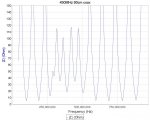
The nulls are 5 Ohm and max are 800 Ohm. If you then connect a second coax to a third scanner the problems add up. A 50 Ohm signal that sees a 5 Ohm impedance doesn't leave much signal left and if that signal goes thru a second 50 Ohm coax and then sees another 5 Ohm at the other end.... A TRX-2 scanners 450MHz setting swings its own filter between 20 Ohm and 170 Ohm.
Using a bit longer coax of 110cm change the frequency where the nulls are.
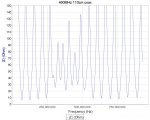
Using a $5 CATV splitter makes the signal immune to other scanners and the impedance are held fairly constant between 40 and 90 Ohm. Altering the coax lenght only moves the curves slightly in frequency and are bareley noticable. The sweeps looked almost identical independent of the scanners frequency band and coax lenghts.
The same problem exists in antenna feeds. But if you use an amplifier at the antenna that feeds the coax with an almost constant impedance independent of the antennas impedance and have a CATV splitter down at the scanners that loads the coax with an constant impedance, then the problems are minimal.
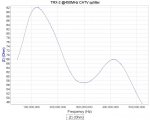
/Ubbe
Last edited:
prcguy
Member
Ok, I'm home sick today but just for Jon I grabbed a 4-way power divider, signal source and power meter to show how a splitter works backwards as a combiner. The power divider is an Anzac DS-409-4 and perfect for scanner use with a 10MHz to 2GHz frequency response and good RF specs. The signal source is around 0dBm at 146MHz, well within the useful range of the power divider.
Pic 1 shows the output level of just the 146MHz signal source at .33dBm.
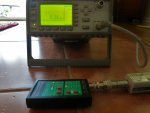
Pic 2 shows the splitter connected as a splitter with the signal source outputting .33dBm into the common port and -9.07dBm is left at one of the splitter outputs.

Pic 3 shows the splitter connected as a combiner with the signal source outputting .33dBm into one of the four output ports and the resulting signal at the input port is -9.23dBm.
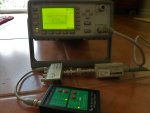
The theoretical loss of a 4-way divider or combiner is 9dB plus whatever internal loss it has and this divider is working very well despite all the other ports being unterminated. Being very broad band I believe this splitter is a transformer type, but all splitters will work the same regardless of internal topology.
Got any comments Jon? Is there anything else I can do to show you how a splitter/combiner works? Just let me know!
Pic 1 shows the output level of just the 146MHz signal source at .33dBm.

Pic 2 shows the splitter connected as a splitter with the signal source outputting .33dBm into the common port and -9.07dBm is left at one of the splitter outputs.

Pic 3 shows the splitter connected as a combiner with the signal source outputting .33dBm into one of the four output ports and the resulting signal at the input port is -9.23dBm.

The theoretical loss of a 4-way divider or combiner is 9dB plus whatever internal loss it has and this divider is working very well despite all the other ports being unterminated. Being very broad band I believe this splitter is a transformer type, but all splitters will work the same regardless of internal topology.
Got any comments Jon? Is there anything else I can do to show you how a splitter/combiner works? Just let me know!
Not true if the combiner uses transformers to match impedance rather than resistors. A transformer-based splitter/combiner works as I described.
Last edited:
- Status
- Not open for further replies.
Similar threads
BCD325P2/BCD996P2:
Scanner Problems After Power Outage?
- Replies
- 17
- Views
- 954
- Locked
- Replies
- 0
- Views
- 2K
- Replies
- 0
- Views
- 307
- Replies
- 15
- Views
- 735

